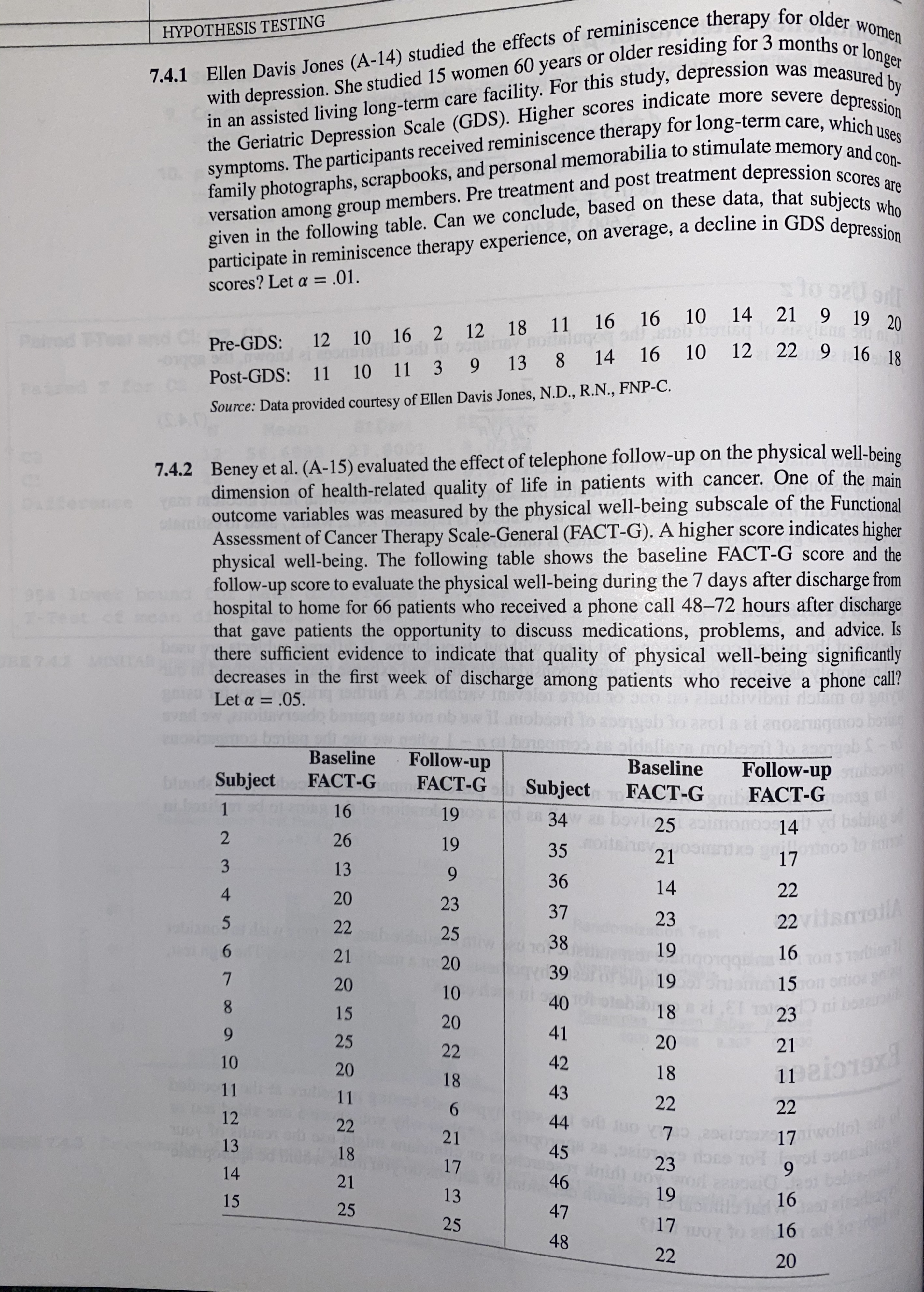
MATLAB: An Introduction with Applications
6th Edition
ISBN: 9781119256830
Author: Amos Gilat
Publisher: John Wiley & Sons Inc
expand_more
expand_more
format_list_bulleted
Concept explainers
Topic Video
Question
please help with 7.4.1

Transcribed Image Text:ke following exercises, carry out the ten-step hypothesis testing procedure at the specified
ifcance level. For each exercise, as appropriate, explain why you chose a one-sided test or
wO-sided test. Discuss how you think researchers or clinicians might use the results of vour
bunothesis test. What clinical or research decisions or actions do you think would be appropriate
in light of the results of your test?

Transcribed Image Text:7.4.1 Ellen Davis Jones (A-14) studied the effects of reminiscence therapy for older women
with depression. She studied 15 women 60 years or older residing for 3 months or longer
HYPOTHESIS TESTING
in an assisted living long-term care facility. For this study, depression was measonger
the Geriatric Depression Scale (GDS). Higher scores indicate more severe de cd by
scores
symptoms. The participants received reminiscence therapy for long-term care, which uses
family photographs, scrapbooks, and personal memorabilia to stimulate memory and con-
Scores are
given in the following table. Can we conclude, based on these data, that subjects who
participate in reminiscence therapy experience, on average, a decline in GDS depression
versation among group members. Pre treatment and post treatment depression
%3D
scores? Let a = .01.
21 9 19 20
12 18 11 16 16 10
10
14
Paired TTeat
Pre-GDS: 12 10 16 2
12 22 9 16 18
Post-GDS: 11 10 11 3 9 13 8 14 16
Source: Data provided courtesy of Ellen Davis Jones, N.D., R.N., FNP-C.
7.4.2 Beney et al. (A-15) evaluated the effect of telephone follow-up on the physical well-being
dimension of health-related quality of life in patients with cancer. One of the main
outcome variables was measured by the physical well-being subscale of the Functional
Assessment of Cancer Therapy Scale-General (FACT-G). A higher score indicates higher
physical well-being. The following table shows the baseline FACT-G score and the
follow-up score to evaluate the physical well-being during the 7 days after discharge from
hospital to home for 66 patients who received a phone call 48-72 hours after discharge
that gave patients the opportunity to discuss medications, problems, and advice. Is
there sufficient evidence to indicate that quality of physical well-being significantly
decreases in the first week of discharge among patients who receive a phone call?
nce
7-Test ce
RE74 MNIAL
Let a = .05.
%3D
baning
Baseline
arola ai anoahsgnoo bong
Idelisa mobasit lo 2e
Follow-up
Follow-up
Baseline
blaod Subject
nias 1
FACT-G
FACT-G
Subject
28 34
FACT-G
FACT-G
16
19
25
14
babing of
26
noo lo
17
19
35
21
13
9.
36
14
22
4
20
37
23
22vialA
22
25
38
TonS 7rion
15 on oho
Dai bonu
21
19
16
20
39
20
19
10
8.
15
40
18
23
20
6.
41
25
22
20
0.307
21
10
20
42
1naio1ax
18
18
11
11
43
6.
22
22
12
22
44
21
17 twollol
13
18
45
17
23
9.
bobie-m
16
14
21
46
15
13
19
25
47
25
17
16
48
22
20
23
Expert Solution
This question has been solved!
Explore an expertly crafted, step-by-step solution for a thorough understanding of key concepts.
This is a popular solution
Trending nowThis is a popular solution!
Step by stepSolved in 2 steps with 4 images

Knowledge Booster
Learn more about
Need a deep-dive on the concept behind this application? Look no further. Learn more about this topic, statistics and related others by exploring similar questions and additional content below.Similar questions
- Recall that a mile is equal to 1.6093 kilometers. If a runner can maintain an average pace of400 meters every 127 seconds, how many hours will it take the runner to complete ahalf-marathon, which is a 13.1-mile race?arrow_forwardPredict the value of the painting in 2025arrow_forward-3.7n=33.3arrow_forward
arrow_back_ios
arrow_forward_ios
Recommended textbooks for you
 MATLAB: An Introduction with ApplicationsStatisticsISBN:9781119256830Author:Amos GilatPublisher:John Wiley & Sons Inc
MATLAB: An Introduction with ApplicationsStatisticsISBN:9781119256830Author:Amos GilatPublisher:John Wiley & Sons Inc Probability and Statistics for Engineering and th...StatisticsISBN:9781305251809Author:Jay L. DevorePublisher:Cengage Learning
Probability and Statistics for Engineering and th...StatisticsISBN:9781305251809Author:Jay L. DevorePublisher:Cengage Learning Statistics for The Behavioral Sciences (MindTap C...StatisticsISBN:9781305504912Author:Frederick J Gravetter, Larry B. WallnauPublisher:Cengage Learning
Statistics for The Behavioral Sciences (MindTap C...StatisticsISBN:9781305504912Author:Frederick J Gravetter, Larry B. WallnauPublisher:Cengage Learning Elementary Statistics: Picturing the World (7th E...StatisticsISBN:9780134683416Author:Ron Larson, Betsy FarberPublisher:PEARSON
Elementary Statistics: Picturing the World (7th E...StatisticsISBN:9780134683416Author:Ron Larson, Betsy FarberPublisher:PEARSON The Basic Practice of StatisticsStatisticsISBN:9781319042578Author:David S. Moore, William I. Notz, Michael A. FlignerPublisher:W. H. Freeman
The Basic Practice of StatisticsStatisticsISBN:9781319042578Author:David S. Moore, William I. Notz, Michael A. FlignerPublisher:W. H. Freeman Introduction to the Practice of StatisticsStatisticsISBN:9781319013387Author:David S. Moore, George P. McCabe, Bruce A. CraigPublisher:W. H. Freeman
Introduction to the Practice of StatisticsStatisticsISBN:9781319013387Author:David S. Moore, George P. McCabe, Bruce A. CraigPublisher:W. H. Freeman

MATLAB: An Introduction with Applications
Statistics
ISBN:9781119256830
Author:Amos Gilat
Publisher:John Wiley & Sons Inc

Probability and Statistics for Engineering and th...
Statistics
ISBN:9781305251809
Author:Jay L. Devore
Publisher:Cengage Learning

Statistics for The Behavioral Sciences (MindTap C...
Statistics
ISBN:9781305504912
Author:Frederick J Gravetter, Larry B. Wallnau
Publisher:Cengage Learning

Elementary Statistics: Picturing the World (7th E...
Statistics
ISBN:9780134683416
Author:Ron Larson, Betsy Farber
Publisher:PEARSON

The Basic Practice of Statistics
Statistics
ISBN:9781319042578
Author:David S. Moore, William I. Notz, Michael A. Fligner
Publisher:W. H. Freeman

Introduction to the Practice of Statistics
Statistics
ISBN:9781319013387
Author:David S. Moore, George P. McCabe, Bruce A. Craig
Publisher:W. H. Freeman